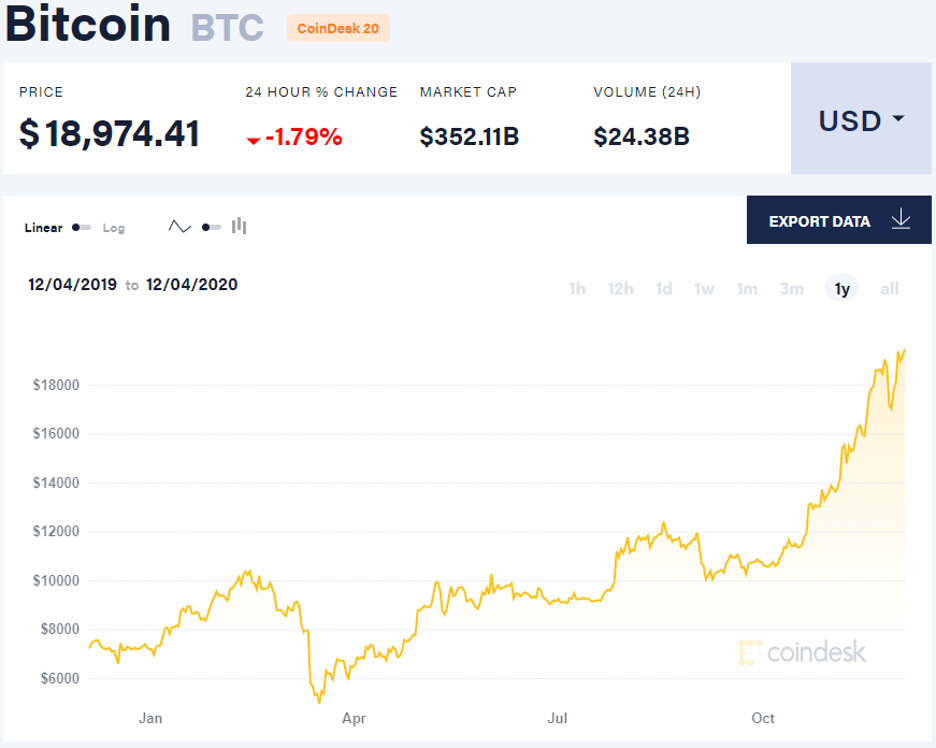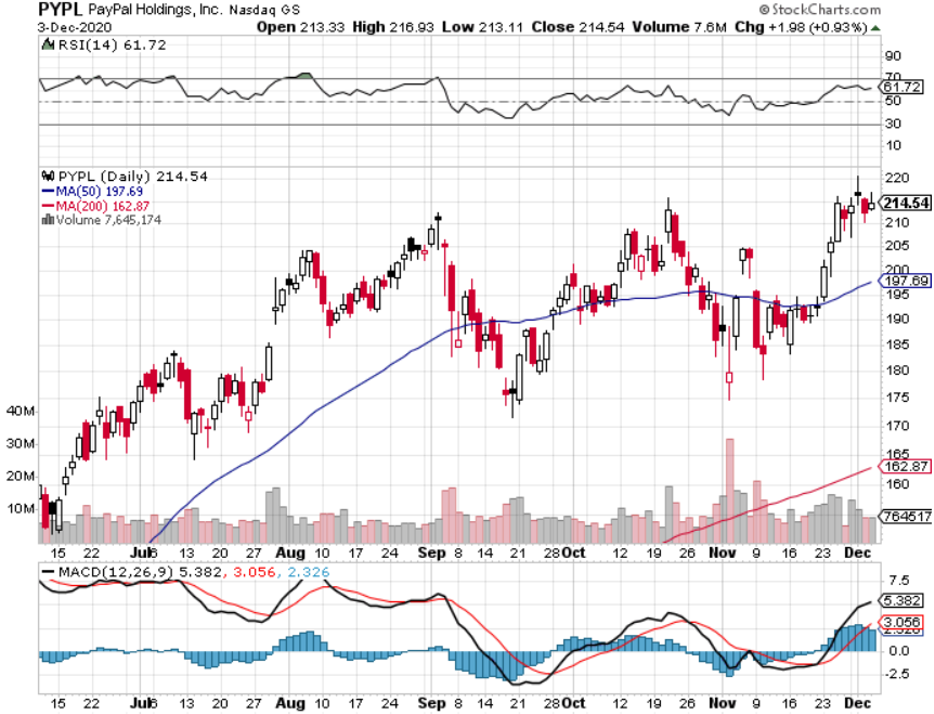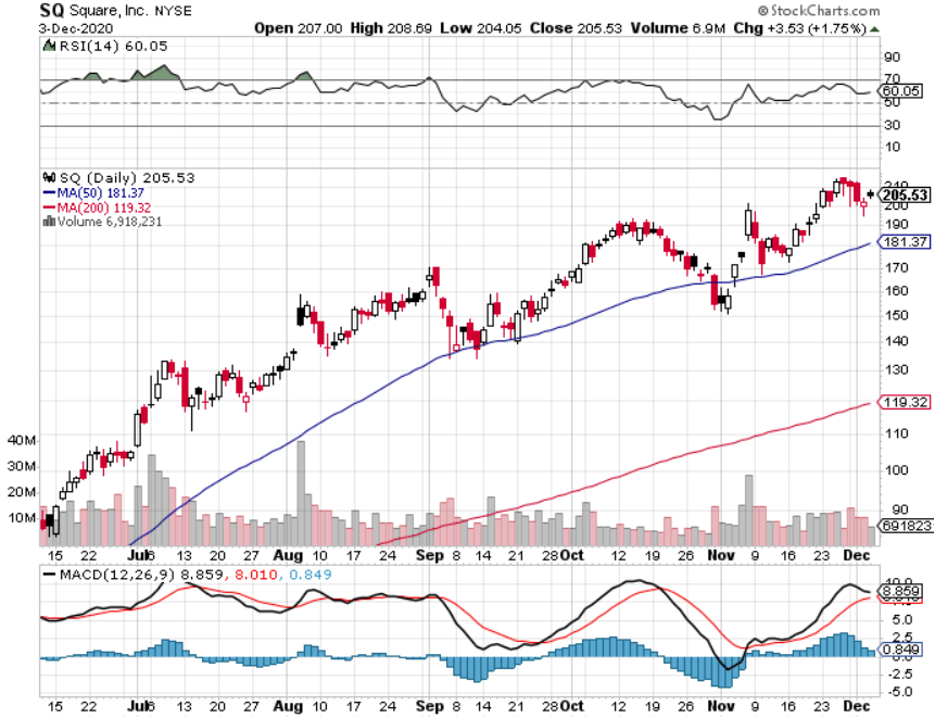The Normalization of Cryptocurrency
The price of Bitcoin mushrooming to an all-time peak of just south of $20,000 is a seminal moment for digital currencies.
Although the Mad Hedge Technology Letter rarely wades into these types of waters, crypto must be addressed because the recent legitimization of digital currencies cannot be diminished.
That’s not to say they will be the de facto monetary instrument tomorrow morning, but the concept of digital currencies and development of it this year has been far and wide-reaching.
The price of Bitcoin has gained more than 170% this year, with most of the price action coming since September.
Why has it been so successful?
Riskier assets are back in vogue as the unprecedented fiscal and monetary stimulus means there are fewer places to achieve any sort of proper yield.
Then consider recent mainstream acceptance that is coming to full fruition such as payment companies including PayPal (PYPL) and Square (SQ) which have recently incorporated digital currencies into their business model.
Government and Central Banks are the largest reason for the short-term elevated attention as their fumbled virus response has led to lockdowns and a massive loss of trust in their leadership.
The global debacle has led many investors to search for alternative routes to fiscal safe havens seeking shelter from rapidly increasing central bank quantitate easing and the rampant asset inflation that everyone agrees is already taking place.
Much of the money printing has not been done responsibly with mainly only corporations and their offshoots benefiting from an unprecedented, pandemic-marred market reality in which stocks are trading at nosebleed prices while bond yields are hovering around zero.
Moving forward, the risk of protests, revolution, and war has increased significantly in large swaths of the developed and undeveloped world and higher societal and systemic risk makes the idea of digital currencies that are out of the reach of taxable authorities more conducive to storing savings and for-profit trading.
Bonds have no yield EVERYWHERE at this point and keeping wealth in cash is dangerous.
Investors used to put their money in gold, but gold is going down because it is being replaced by digital gold called bitcoin.
It was only in 2017 when the bitcoin surge lost momentum and caused the price of Bitcoin to lose half its value within days of reaching an all-time high.
What is the difference today?
Today’s bull market is resting upon more solid foundations and in 2017, the bubble was artificially propped up by Initial Coin Offerings (ICOs), which saw charlatans sell mostly worthless new currencies to the naïve retail investor.
It’s true that today, Bitcoin is regulated tighter translating to less dumb money circulating in the system.
Bitcoin’s foundations are also more firm in 2020 because its adoption base has increased meaning more people have skin in the game and aren’t going to dump the asset at the first sign of consolidation.
A company called Grayscale has been quite intelligent in pitching Bitcoin as an alternative to gold and selling it to millions of millennial investors in the form of shares.
The large avoidance of corporate bitcoin adoption has changed 180 degrees in the year of the pandemic with PayPal announcing last month that it will soon allow users to buy cryptocurrency within its app.
Next year, PayPal will allow users to draw from cryptocurrency accounts to pay for goods and services at 28 million merchants that use the company's platform.
PayPal will also enable customers to use Venmo, its popular peer-to-peer payment service, to buy and shop with cryptocurrencies.
CEO Dan Schulman implied that the size of the waiting list for last month's crypto offering for access to crypto was two or three times as great as what the company anticipated.
Obviously, this is setting up a shortage of bitcoin in more corporates needing access to its supply.
Schulman also argued that companies and central banks are experimenting with cryptocurrencies and the utility of digital wallets.
“Digital wallets are a natural complement to all forms of digital currency,” said Schulman, adding that PayPal is in close talks with central banks and regulators to explore new uses for these wallets.
Schulman said PayPal views cryptocurrency systems as cheaper and more efficient than ACH, which is the network that supports the existing banking system.
He also said that the current financial system is “not working” for many low-income people meaning that there is a huge untapped audience that would find crypto more useful.
Last week, cryptocurrency giant Coinbase announced a debit card that can be used at ordinary merchants, while MasterCard in September announced a service to let central banks test out digital currencies.
There are strong rumblings by investors that gold will eventually be displaced by “digital gold” and abandoning the sinking ship early could lead to all gold investors diverting their capital into bitcoin.
This would massively expand the user base as well and the valuation could be 25 times higher than it is today.
Institutions have taken the baton from the retail-driven pandemonium of 2017 and in 2020, many liquid investors will look at any crash or dip in bitcoin as a buying opportunity.
What a change from just 4 years ago!
I hate to say it, but as central banks go even more off the deep end to prop up a decaying financial system riddled with conflicts of interest, the price of bitcoin will gain in strength resulting in much higher prices.
Not only that, but the adoption rate could also go into overdrive opening up pathways for secondary coins like Ethereum to gain widespread adoption as well.
At this point, it appears that this overarching trend is unstoppable, and in the future, historians will look at this 2nd bull run to $20,000 in 2020 as just another data point in its meteoric rise to jaw-dropping prices of $30,000 then $40,000.






